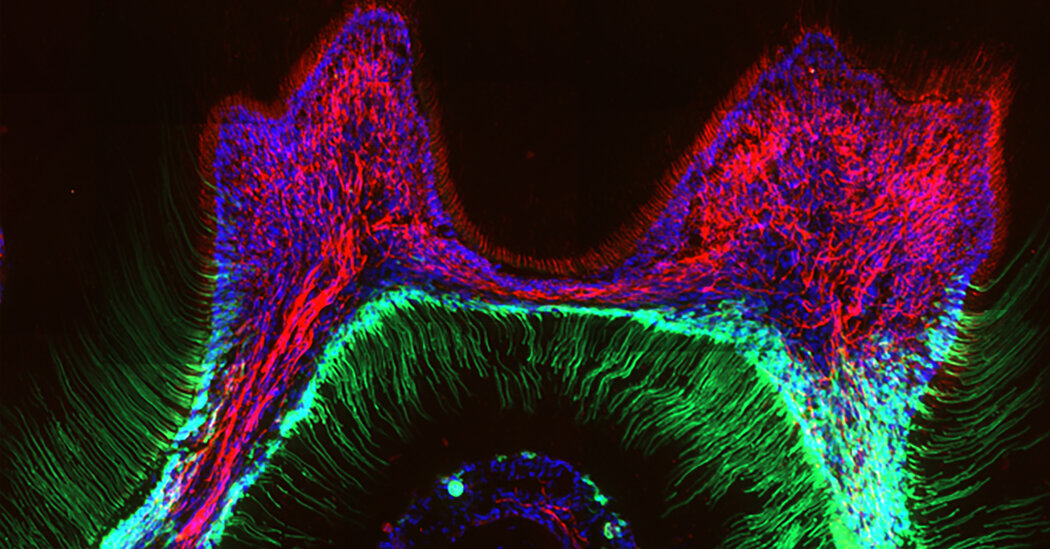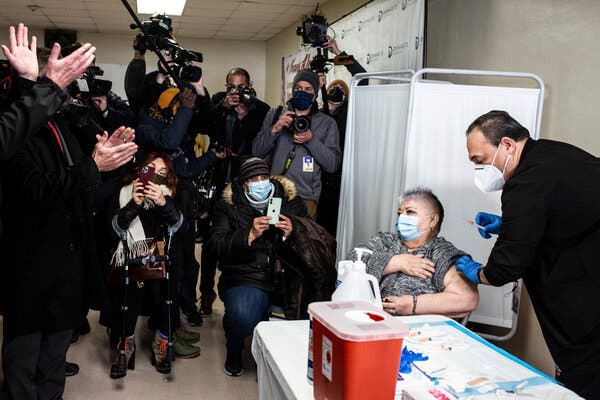When Laura Drager contracted Covid-19 in July, it was as though someone had suddenly muted her olfactory system.One morning she was sipping her favorite Gatorade (the yellow one), and two hours later the drink was completely flavorless. She immediately lit a candle and blew it out, but she couldn’t smell the smoke.Her sense of smell had disappeared. Now, she said, “everything either tastes like bleach or tastes like nothing.”Over the past few months she has lost 19 pounds. “I don’t have that ‘I’m hungry’ feeling,” said Ms. Drager, 41, who lives in Sevierville, Tenn., about 45 minutes from Knoxville. “I think you forget how much smell and taste is a part of your life until it goes away.”As the coronavirus continues to spread, there are increasing numbers of people who have either lost their senses of smell after contracting Covid or are struggling with parosmia, a disturbing disorder that causes previously normal odors to develop a new, often unpleasant aroma.One meta-analysis published in September found that as many as 77 percent of those who had Covid were estimated to have some form of smell loss as a result of their infections.The recommended treatment for these conditions is smell training. But how exactly do you do it, and why should you bother?We spoke with several experts to demystify the process.What is smell training?First, let’s talk about what smell training is not. If the words conjure up images of a “Rocky” training montage — as they did for Tejal Rao, a New York Times restaurant critic who lost her sense of smell after contracting Covid last year — the reality is very different. Smell training is more akin to physical therapy for your nose: tedious and repetitive. It involves sniffing several potent scents twice a day, sometimes for months, to stimulate and restore the olfactory system — or at the very least to help it function better.“It’s not a quick fix,” said Chrissi Kelly, a member of the Global Consortium for Chemosensory Research and the founder of AbScent, a nonprofit based in England and Wales that offers support and education to people around the world who have smell disorders. “You have to keep up with it.”If it has been a couple of weeks since you lost your sense of smell and it hasn’t started to come back, then it makes sense to start smell training. When your smell starts to come back, it might happen gradually rather than all at once. At first, scents might seem distorted or foul.Scientists are still learning about all of the mechanisms by which the coronavirus affects the olfactory system, but they believe parosmia occurs because the neural pathways from the nose to the brain have been disrupted, “kind of like a telephone operator from the 1950s connecting the wrong party to another line,” said Pamela Dalton, a faculty member at the Monell Chemical Senses Center, a nonprofit research institute in Philadelphia.For most people, parosmia is a symptom of recovery, and that’s why experts believe smell training can be beneficial as you continue to heal.Patricia Voulgaris for The New York TimesWhy smell training?Even if you’re devastated over having lost your sense of smell, you might be thinking: Do I really need to add smell training to my to-do list? Won’t my sense of smell return eventually all by itself?For many people, it appears to come back within weeks of being infected.A study published in January that recruited patients from 18 European hospitals found that among 1,363 coronavirus patients with olfactory dysfunction, most recovered their senses of smell within two months and 40 percent saw their ability to smell return within two weeks. All patients were encouraged to follow two daily sessions of smell training at home, said Dr. Jerome R. Lechien, a professor of otolaryngology at the University Hospital of Brussels and one of the authors of the study. Though it’s unclear how many patients did the training, nearly one-quarter were still experiencing smell dysfunction 60 days after the onset of their symptoms. By the six-month mark, 95 percent of the patients had recovered their senses of smell.Robust studies examining the efficacy of olfactory training among Covid survivors have not yet been published. Several studies, however, have demonstrated that smell training can help people who have lost some or all of their senses of smell to other viral illnesses like sinus infections — that’s why it is widely considered the best option for those who can no longer smell properly after contracting Covid.“It has no risk — except boredom,” Dr. Dalton said wryly.Before you begin, however, it is wise to rule out other conditions that could be affecting your sense of smell.“I saw somebody recently who had smell dysfunction following Covid-19, and it turned out they had inflammatory nasal polyps,” said Dr. Sunthosh K. Sivam, an ear, nose and throat specialist and an assistant professor at the Baylor College of Medicine in Houston. Once he removed the polyps, which were unrelated to Covid, his patient’s sense of smell improved greatly.“Seeing an E.N.T. is a good way to make sure nothing else is missed,” he added.How do you choose your scents?To start, decide on four scents that are familiar to you and that evoke strong memories, the experts said. These are the fragrances that you will stick with throughout the initial phase of your training. Maybe one of them is a scented shampoo, a favorite cologne or lemons from the tree in your backyard. An avid home cook, for example, might use certain spices from his pantry.Alternatively, “some people have had a lot of success with things that smell bad,” Dr. Dalton said.At one point during her smell training, Ms. Rao, the restaurant critic, used spoiled milk. Ms. Drager, who had Covid-19 over the summer, extinguishes a candle every day and tries to smell the smoke.If that doesn’t sound appealing, you can choose to buy a smell kit that contains essential oils: the classic scents are rose, eucalyptus, clove and lemon. The kits usually retail for under $50.Or you can purchase these oils yourself at a place like Whole Foods. Ms. Kelly includes instructions on how to make your own scent kit on the AbScent website.If you buy your own oils and you want to smell them directly from the open container, first ask someone who isn’t smell impaired to try it. Then ask whether the person can easily smell the fragrance when the scent is a few inches below his or her nose. (Some containers have such small openings that it might be difficult to get a good whiff.) In the process, avoid getting any of the oils on your skin because they are highly concentrated.How does smell training work?There is not one uniform, universal way of undergoing smell training, but the experts we spoke with offered similar advice.They recommend keeping your scents in an easily accessible location — such as by your bedside — and smelling each scent for about 20 seconds so that the entire smell-training session lasts approximately one minute.While you’re doing this, take short sniffs rather than deep inhales, recommended Ms. Kelly of AbScent as she demonstrated a series of repetitive whiffs that she referred to as “bunny sniffs.”While you’re smelling the fragrances, it often helps to look at a picture of the thing that you’re smelling, said Dr. Nicholas R. Rowan, an assistant professor of otolaryngology-head and neck surgery at the Johns Hopkins University School of Medicine in Baltimore.Then, try to imagine what the item used to smell or taste like to you.“It’s not simply the act of smelling something, but it’s also this sort of mindful imagining of what that smelled like when you were eating it or when you put it on your skin — if it was a lotion, for example,” Dr. Dalton said. “It just makes it more enjoyable to continue with the process.”Smelling something that is connected to a memory or emotion is ideal, she said, because the brain plays such a big role in how we perceive smell.How long do you need to do it?Generally, doctors advise their patients to do smell training twice a day for three months.“Keep on training for a year if you have to,” said Dr. Thomas Hummel, a researcher at the Smell and Taste Clinic of the otorhinolaryngology department at the Technical University of Dresden in Germany, whose work has informed the odor training methods now used around the world.The success of your training depends on a variety of factors, including your age. In general, younger people recover their sense of smell after a viral illness at a higher rate than older people, Dr. Hummel added. This is partly because older people tend to have fewer olfactory receptor neurons — the cells that detect and transmit information about smells to the central nervous system — and their receptor neurons do not regenerate as quickly.“When you’re older, everything is slower,” he said.How do you stay motivated?As with any process that doesn’t yield immediate results, you may find it difficult to stick with the plan.“It’s very frustrating for patients,” Dr. Rowan said. “They seek out this care because they can’t smell and want it fixed and then we say, ‘Hey, use this sensory function that you don’t have.’” But, he added, “this is the best thing out there.”He suggested using a calendar to record each scent training session in order to build the habit.Keeping a diary can also be helpful, Ms. Kelly said, so that you can take notes on what you’re experiencing during each session. For further motivation, the AbScent website offers an app called Snif that can help you track your progress.Finally, if you don’t know many people who have a smell dysfunction, consider joining an online community for support and inspiration. The AbScent Facebook group for people with Covid has grown to more than 25,000 people, Ms. Kelly said.As for Ms. Drager, although she is still working to heal her olfactory system, she did smell a lemon scent this year for the first time since her sense of smell disappeared.She cried with relief.“I’m making slow progress,” she said.
Read more →






